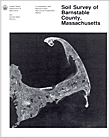The following is a map unit description from the "Soil Survey of Barnstable County, Massachusetts (Fletcher, 1993)"

MbA-Maybid Variant silty clay loam, 0 to 1 percent slopes. This very deep, level, poorly drained soil is in low areas along the Herring River in the northwestern section of the town of Welifleet. The soil formed in tidal marsh deposits that are no longer subject to tidal flooding and have been drained of salt water. It makes up about 0.1 percent of the survey area. It is mapped mainly in the Ipswich-PawcatuckMatunuck general soil map unit. Areas are irregular in shape and are about 360 acres in size.
Typically, the surface layer is about 3 inches of black muck. Below this is a layer of dark grayish brown, mottled, friable silty clay loam about 12 inches thick. The subsoil is dark grayish brown, friable silty clay loam about 6 inches thick. The substratum extends to a depth of 65 inches or more. The upper 7 inches is dark greenish gray, mottled, slightly plastic, slightly sticky silty clay loam, and the lower part is very dark gray, slightly plastic, slightly sticky loam.
Included with this soil in mapping are small areas of Berryland and Swansea soils. Also included, in an area of limited extent upstream from tidal gates, are soils that are coarser textured than the Maybid Variant soil and are affected by the leakage of water past the gates. Included soils make up about 10 percent of this unit.
Permeability is moderate to slow in the subsoil of the Maybid Variant soil and slow or very slow in the substratum. Available water capacity is high. Depth to the seasonal high water table is 1.0 to 1.5 feet.
Most areas are used as woodland or support shrubby vegetation. Some open areas support grasses.
This soil is unsuited to most cultivated crops and to hay and pasture. An extremely acid reaction in the surface layer and subsoil, sulfates in the substratum, and the seasonal high water table severely limit most farm uses.
This soil is unsuited to woodland because of the extremely acid reaction in the surface layer and subsoil, the sulfates in the substratum, and the seasonal high water table. Because of low soil strength, the use of equipment should be limited to periods when the soil is dry or frozen. The most common trees are chokecherry, pitch pine, gray birch, and shadbush.
The seasonal high water table is a limitation if this soil is used as a site for dwellings or septic tank absorption fields. The slow or very slow permeability in the substratum also is a limitation on sites for septic tank absorption fields. Alternative sites should be selected.
This soil is well suited to wetland wildlife habitat. The common native plant communities provide adequate food and cover for nesting areas.